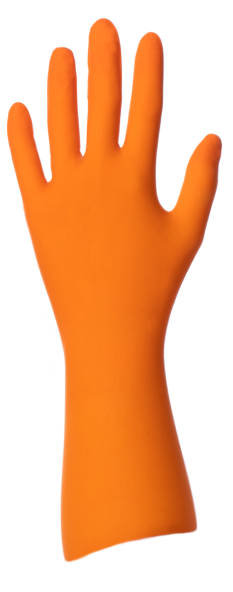HOW TO PREVENT ALLERGIC REACTIONS RELATED TO DISPOSABLE GLOVES?
Due to the exponential use of disposable gloves around the world (more than 400 billion per year according to MARGMA - Malaysian Rubber Glove Manufacturers Association), the risk of developing an allergic reaction in relation to wearing single-use gloves is very high.
Allergy is the result of a dysregulation of the immune system that reacts too strongly to substances generally harmless: allergens.
The allergic reaction does not occur immediately but after a second exposure to the allergen. Indeed, once sensitized to an allergen (the first contact may have gone completely unnoticed), each new exposure with the latter can lead to a disproportionate reaction of the body and therefore manifestations of allergic reactions to each new exposure.
There are 4 types of allergies:
- Type I: this is an immediate type of hypersensitivity related to IgE (antibodies) that occurs immediately or less than an hour after exposure to an allergen.
- Type II: this is an immune reaction in which antibodies (IgG or IgM) are directed against cellular or extracellular antigens. It appears a few minutes or hours after contact with the allergen.
- Type III: also called immunocomplex reactions, it is a semi-delayed reaction mediated by proteins and antibodies reacting to allergens and that can be serious. That occurs within a few hours after exposure to the allergen.
- Type IV: also called delayed-type hypersensitivity reaction, this is an allergic reaction due to the secretion of an excessive amount of cytokines (by T cells) that appears from a few hours to a few days after exposure to the allergen.
The most common allergies are Type I and Type IV.
SOURCES OF ALLERGIC REACTIONS BY DISPOSABLE GLOVES
Two main sources are involved in allergic reactions and attributed to single-use gloves:
COMPONENTS OF DISPOSABLE GLOVES
Chemicals used during gloves manufacturing: these are ingredients added to Natural Latex or Nitrile (Butadiene Acrylonitrile) like sulfur which makes vulcanization possible, or other chemicals which make gloves more elastic, more comfortable, more durable over time.... These can also be vulcanization accelerators, such as thiazoles or thiurams that accelerate vulcanization more or less quickly.
Proteins: in this case proteins from natural rubber latex.
Powder: used as a release agent during the manufacturing process, it also makes gloves donning easiest.
Endotoxins: resisting components of the wall from some bacteria contained in raw materials such as latex or result from a poor manufacturing process.
SKIN CONDITIONS
The existence of prior skin conditions (e.g. dry and chapped hands, cracks, eczema, dermatitis ...) can increase the risk of developing allergic reactions.
3 COMMON TYPES OF ALLERGIC REACTIONS RELATED TO DISPOSABLE GLOVES
There are three main allergic reactions that are identified to be related to gloves:
IRRITATIVE CONTACT DERMATITIS
Also known as irritation, irritant dermatitis, or dermatitis. It can be caused by the presence of chemicals, powder, endotoxins, in the gloves or by too much friction.
Nevertheless, other sources of dermatitis should not be ignored such as the use of detergents, disinfectants, alcohol etc. ...
The main symptoms of the irritative contact dermatitis are:
- Itching
- Redness
- Inflammation
- A scaly appearance
- A burning sensation
- Thickening of the skin
- Etc …
ALLERGIC CONTACT DEMATITIS
Also known as Type IV allergy, delayed hypersensitivity, or chemical allergy. More than 2800 agents (chemical or biological) have already been identified as sensitizers. The Type IV allergic reaction can occur with natural latex gloves as well as synthetic gloves. Many of the Type IV allergic reactions are due to the accelerators used in the glove manufacturing process.
The main symptoms of allergic contact dermatitis are:
- Dryness
- Flaky skin
- Skin peeling
- Pimples
- Cracking
- Inflammation
- Skin blisters
- Etc …
ALLERGY TO NATURAL RUBBER LATEX (TYPE I)
Also known as immediate type of hypersensitivity, protein allergy or Type I. All products containing natural rubber latex (gloves, condoms, balloons ...) are potentially sources of type I allergic reaction. Nevertheless, there can be cross-reactions with certain foods (avocado, apple, tomato, banana, cherries, kiwi ...).
The main symptoms of Natural Rubber Latex allergy (Type I) are:
- Urticaria
- Hives
- Asthma
- Hay fever symptoms
- Quincke's edema
- Anaphylaxis
HOW TO PREVENT ALLERGIC REACTIONS DUE TO DISPOSABLE GLOVES?
Actions to limit the risk of irritative contact dermatitis and initial reactions if signs of allergy appear
- Inform his/her hierarchy or the occupational health-care professional.
- Replace the usual gloves with gloves containing low residues of chemicals or endotoxins (refer to the technical data of nitrile or latex gloves provided by the manufacturer and highlighting the low irritant potential of the gloves such as biocompatibility).
- Wear little larger gloves to facilitate the " breathing" of the skin.
- Prefer powder-free gloves.
- Remain cautious with infectious agents.
- Seek a dermatologist if symptoms persist.
Actions to limit the risk of allergic contact dermatitis and initial reactions if signs of allergy appear
- Inform the occupational health-care professional or seek a dermatologist if symptoms persist.
- Replace regular gloves with gloves that are low in chemical residues and sensitizing chemicals.
- Wear only powder-free gloves.
- Wear cotton or nylon inner gloves, make sure to replace them each time disposable gloves are changed.
- If a chemical is identified as the source of the allergy, be sure to wear gloves free of that chemical.
Actions to limit the risk of allergy to Natural Rubber LatexPromptly inform your supervisor and the Occupational health-care professional in case of suspicion of allergic reaction.• Promptly inform your supervisor and the Occupational health-care professional in case of suspicion of allergic reaction.
- Promptly inform your supervisor and the Occupational health-care professional in case of suspicion of allergic reaction.
- Immediately replace natural latex gloves with non-powdered synthetic gloves (nitrile gloves).
- Confirm or not the suspicion of allergic reaction by consulting an allergy specialist who will undertake a medical interview and followed by tests to find the origin of the allergic reaction.
- Inform those around you (HR, colleagues but also dentist etc.) and keep out contact with products containing natural Latex in the work environment.
- Learn how to recognize the first symptoms of allergic reaction to Natural Rubber Latex.
- Remain vigilant to the risks associated with cross-reactions (with food for example).
WHICH DISPOSABLE GLOVES TO SELECT TO LIMIT THE RISK OF ALLERGY?
First, it is recalled that in case of an allergic reaction, it is advisable to refer immediately to the Health & Safety Manager or to the Occupational health-care professional by identifying certain elements:
- Where is the reaction located (arms or hands only)? Close to the glove or not?
- What type(s) of reaction(s) and/or symptoms?
- How long ago the symptoms appeared?
Here are some criteria for selecting disposable gloves to limit the risk of allergic reaction:
| To limit the risk of | Choose disposable gloves with following caracteristics |
|---|---|
| Irritant contact dermatitis | Low chemical content Low level of endotoxins Powder-free |
| Allergic contact dermatitis | Low level of sensitizing chemicals Powder-free |
| Allergy to Natural Rubber Latex | Low protein level Powder-free |
To select the appropriate gloves to your specific needs, consult the SHIELD Scientific Natural Latex and Nitrile Gloves Technical Data Sheets and use our glove selection guide.
Do not hesitate to contact us for any further request.






